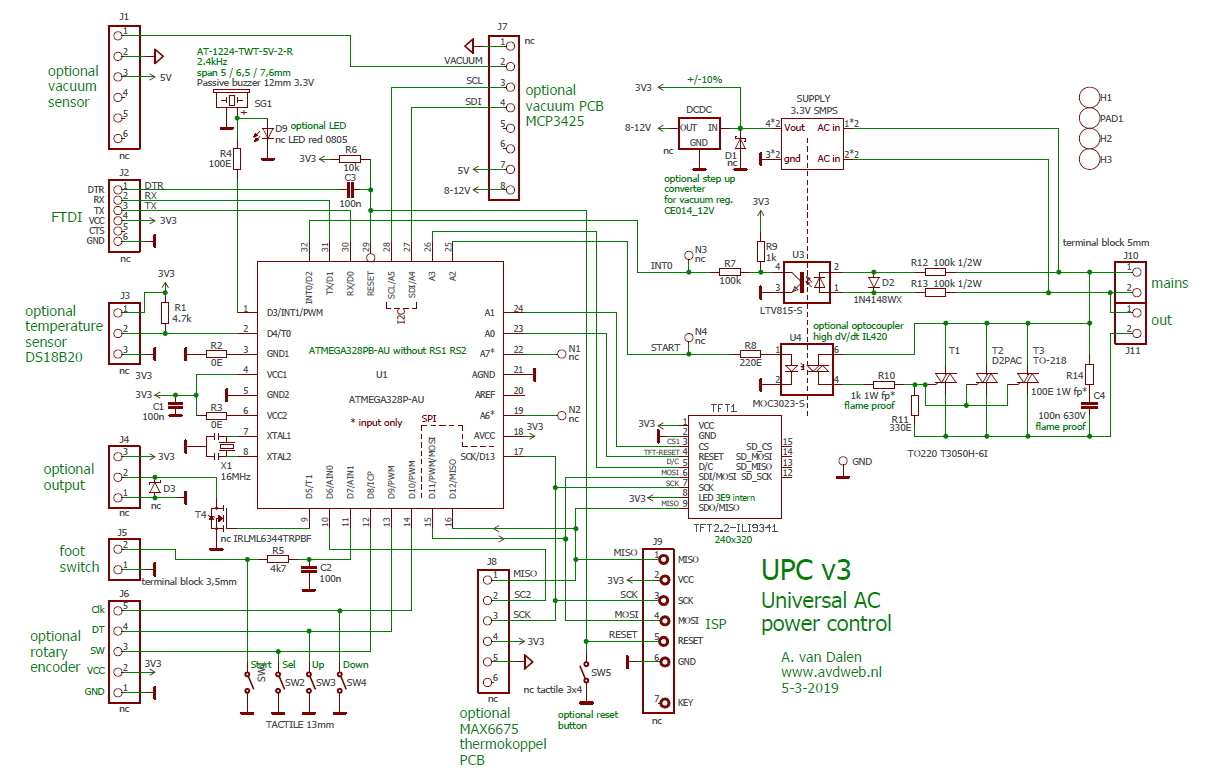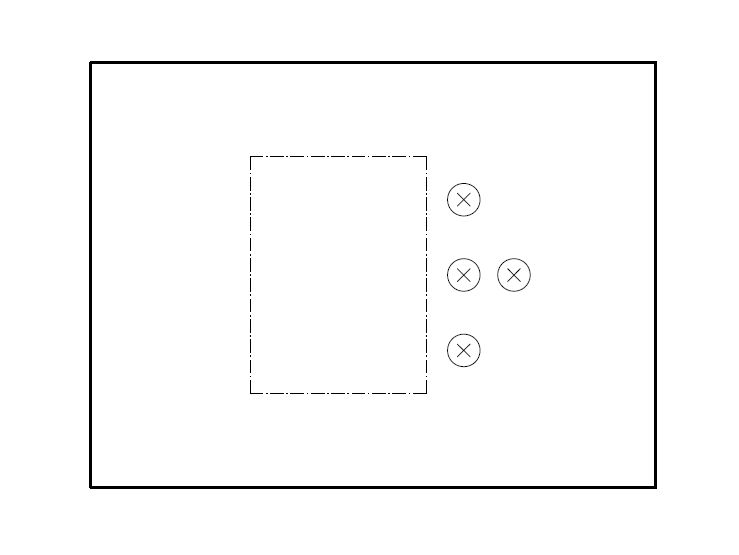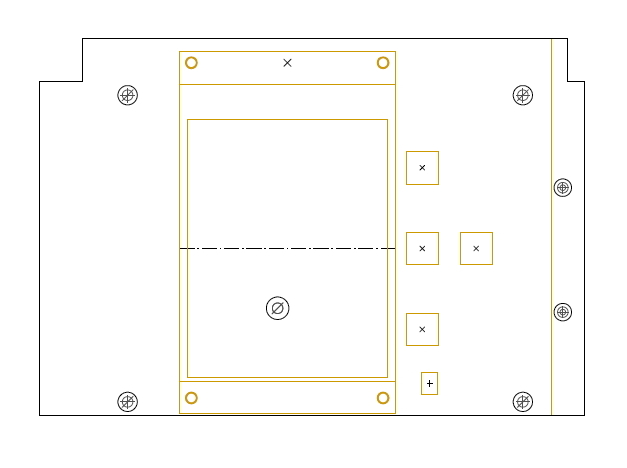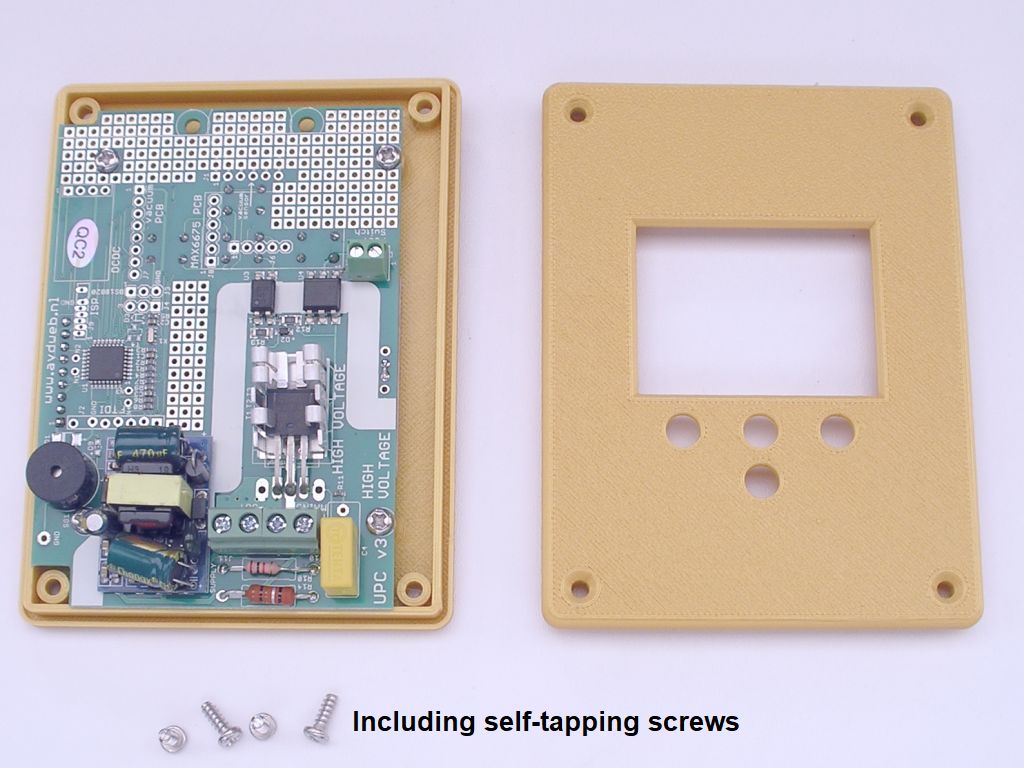Arduino Universal Power Control (UPC) board
- Related articles
- The Arduino Universal Power Control (UPC) board has the following features
- Front panel for the Hammond Electronics enclosure with self tapping screws
- Hammond enclosure
- Snubberless triac
- Optional mounting of heavier triacs
- Drilling the Hammond Electronics enclosure front panel
- Arduino MAX6675 thermokoppel board interface
- Programming by the Arduino IDE
The UPC is an Arduino board, complete with power supply, triac power control, display and menu buttons. Because of the many built-in functions you can quickly and easily create all kinds of useful electronic devices. See the open source PCB Eagle files on GitHub. It includes Gerber files for let making the PCB.
This product is no longer for sale since 7-2020.
Related articles
- Electronic vacuum controller / leakage detector for vacuum infusion and bagging
- Arduino reflow-oven / hot-plate controller
- Dual pulse battery tab spot welder controller with zero crossing detector
 Arduino Power Control Board
Arduino Power Control Board Arduino Power Control Board
Arduino Power Control Board
The Arduino Universal Power Control (UPC) board has the following features
- TFT display
- Menu buttons
- Integrated 3.3V power supply
- Power control which can handle high inductive loads
- Buzzer
- Single board that fits into a standard Hammond Electronics enclosure
- Breadboard for custom modifications
- Arduino ATmega328 with bootloader, programmable via the Arduino IDE
- Optional temperature sensor input DS18B20 (software not implemented)
- MAX6675 thermokoppel board connector
- Optional custom digital output 3.3V (software not implemented)
- Zero cross detection
The Arduino UPC board is already prepared for these applications:
- Spot welder controller
- Vacuum pressure controller
- Thermocouple temperature controller
- Smart solid state relay or dimmer
- Reflow oven controller
Front panel for the Hammond Electronics enclosure with self tapping screws
See the article about the spotwelder controller.
Hammond enclosure
The PCB fits exactly into the Hammond Electronics 1591XXSGY enclosure.
Snubberless triac
Standard TRIACs have turn-off problems with inductive loads. Therefore, a high power alternistor is used here, also named as:
- Snubberless triac
- Three-quadrant triac
- High commutation triac
- Alternistor
Alternistors can be purchased through Mouser as well as on eBay.
The RC snubber network R14 and C4 protects the circuit from voltage transient spikes. The FTDI connector J2 is for re-programming. The ISP connector J9 is for burning the Arduino bootloader.
 Spot welding pulse timer control panel with TFT display circuit
Spot welding pulse timer control panel with TFT display circuit
Connectors
- J1 vacuum sensor
- J2 FTDI programming by the Arduino IDE
- J3 temperature sensor DC18B20
- J6 rotary encoder
- J7 vacuum pressure controller PCB
- J8 MAX6675 thermokoppel board connector
Optional mounting of heavier triacs
On the circuit diagram, 3 triacs are drawn, but only one has been mounted (with TO-220 housing). Optionally, a heavier triac can be mounted with a TO-218 or D2PAC housing.
For big spot welders, take the BTA100-800B, it's for sale on AliExpress. Mount it on a heatsink and wire it to the PCB.
Drilling the Hammond Electronics enclosure front panel
The Arduino UPC board is made to fit into the standard Hammond Electronics enclosure nr. 1591XXSGY:
 Hammond Electronics enclosure front panel drilling
Hammond Electronics enclosure front panel drilling
 Arduino Universal Power Control drilling holes
Arduino Universal Power Control drilling holes
To print out at 1:1, open this PDF FILE.
Arduino MAX6675 thermokoppel board interface
For Arduino applications that require a thermokoppel, a MAX6675 board can be inserted as shown here:
 Arduino MAX6675 thermokoppel board interface
Arduino MAX6675 thermokoppel board interface
Programming by the Arduino IDE
For programming the UPC board by the Arduino IDE, you need a 3.3V FTDI breakout module and a female header. Note that there are fake 3.3V FTDI breakouts: Fake FTDI adapter 5V/3.3V breakouts without regulator.




